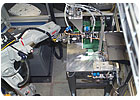Spurred on by increasing demand, Grote Industries (Madison, IN) recently decided to implement robotic assembly to improve productivity.

In the first of two automated cells, an operator loads parts onto a rotary indexing table, which presents the parts to a robot that performs terminal insertion and then places each subassembly back on the table.
“Material savings alone easily paid for the robot cells,” says Grote plant manager, Tom Blades. “Five or six operators per shift were needed to run the parts on a manual line, and depending on the product being run, cycle time was 19 to 24 seconds per part. With the robot cells, we only need two operators per shift, and cycle time is 12 to 15 seconds a part, so we can run parts nearly twice as fast.”
Automating the process has also improved quality. “The cosmetic look of the parts is much better now that they’re being built by robots,” says Grote product development engineer Ed Sitarski. “We also have improved traceability. Parts are laser-etched with identifiers indicating the date, time and shift they were built.”
In terms of flexibility, Blades provides the following outline: “Each cell can run 10 different parts, and we have 10 product types, each with two color variances, red and amber. We have three different types of packaging, bags, totes and boxes. So we have about 60 part numbers that we can change over to, as needed.” Changeover requires less than five minutes, Blades adds.
In terms of specific layout, the first cell includes three six-axis HP6 robots from Motoman Inc. (West Carrollton, OH) equipped with custom grippers. Quick-change fingers enable the grippers to handle various part types. To minimize floor space requirements, the cell also employs a Motoman MSR-500 three-position rotary turntable with part fixtures. The table serves three different stations: an operator station, soldering and potting, and terminal insertion. When processing in this cell is complete, the subassemblies are indexed back to the operator, who adds a lens to each subassembly and transfers it to fixturing in the second cell.
In the second cell, another Motoman HP6 robot welds, greases, laser etches, tests and labels the lamps. Vibration, ultrasonic and spin welders are mounted on a welder anchor rail for interchangeability. The different welders are easily changed out as required, depending on the type of part being run.
“This plug-and-play arrangement for the welders saves on floor space and auxiliary support equipment,” Blades says.
A graphical user interface includes visual overlays of the cell with touch screens that allow users to navigate through different layers, from an overview of both cells to individual cells, to individual components. Sitarski says operators use this system to control part changeovers, diagnose faults, adjust shift information, track production, track rejects, enter packaging requirements and access resources like manuals and part drawings. “The operators are delighted with the control screens and how easy the system is to run, as well as the ergonomics,” Sitarski says.
For more information on robotics, visitwww.motoman.comor call 937-847-6200.